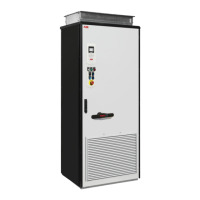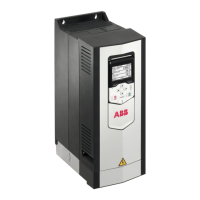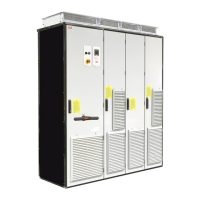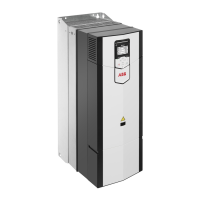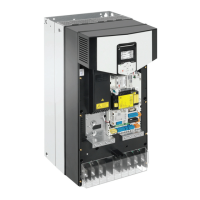22 Planning – basics
Example 1
Common DC system: The DC links of three converters ACS880-01-11A0-5, 5.5 kW (frame
size R1), ACS880-01-034A-5, 18.5 kW (frame size R3) and ACS880-01-034A-5, 18.5 kW
(frame size R3) are connected together. The input terminals of the 5.5 kW converter are
left unconnected.
Calculating the rectifier power capacity
According to the table, k = 0.9 when two converters of frame size R3 are connected to the
AC power line, and P
rec,ave
becomes:
P
rec,ave
= 18.5 kW + (0.9 ×18.5 kW) = 35.15 kW
Example 2
Common DC system
: The DC links of three converters ACS880-01-124A-5, 75 kW (frame
size R6), ACS880-01-180A-5, 110 kW (frame size R7) and ACS880-01-414A-5, 250 kW
(frame size R9) are connected together. All three converters are connected to the AC
power line.
Calculating the rectifier power capacity
According to the table, k = 0.9 when converters of frame size R6 and R7 are connected to
the AC power line, and k = 0.3 when converters of frame size R6 and R9 are connected to
the AC power line. The lowest factor is used in the calculations, that is, k = 0.3, and
P
rec,ave
becomes:
P
rec,ave
= 250 kW + (0.3 × 110 kW) + (0.3 × 75 kW) = 305.5 kW
Verifying the charging capacity of the common DC system
After you select the drives that you will connect to the AC power line, you must verify that
there is enough charging capacity available.
Select the appropriate verification method and obey the related instructions:
1. If you only use drives with Type A charging circuit, make sure that both of these
conditions are true:
• The total charging resistance is high enough. See section Checking the total
charging resistance on page 23.
• The fuses, main contactor and other AC line-side components can withstand the
peak current during the charging. See section Checking the peak AC current at
charging on page 24.
2. If you use drives with Type B charging circuit, obey the instructions in subsection
Checking the charging energy on page 24.
Note: If you use both drives with Type A and Type B charging circuits and you connect
only Type B drives to the AC power line, select the verification method number 2 above.
Note: If you use both drives with Type A and Type B charging circuits AND you connect
both types of drives to the AC power line, you must separate the DC links of those drives
from each other during the charging. Then you actually have two (or several) separate DC
links from the charging capacity point of view, and you can verify the charging capacity of
each DC link separately. Select the appropriate verification method (number 1 or 2) above.
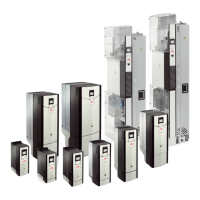
